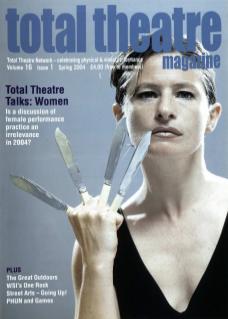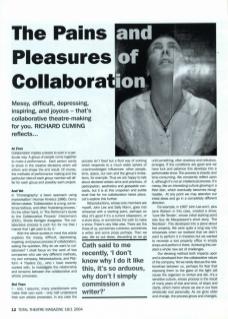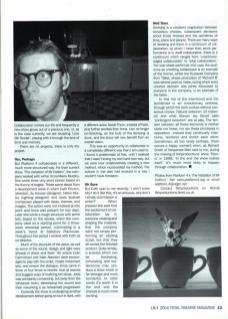At First
Collaboration implies a desire to work in a particular way. A group of people come together to make a performance. Each person wants to share in the creative decisions which will inform and shape the end result. Of course, the methods of performance making and the particular roles of each group member will differ for each group and possibly each project.
And Yet
In Choreography: a basic approach using improvisation (Human Kinetics 1986), Cerny Minton states: ‘Collaboration is a long, sometimes tedious, and often frustrating process.’ On the other hand, in The Performer's Guide to the Collaborative Process (Heinemann 2001), Sheila Kerrigan disagrees: 'The collaborative process is such fun for me that I marvel that I get paid to do it.’
With the above quotes in mind this article explores the messy, difficult, depressing, inspiring, and joyous process of collaboration, asking the question, Why do we want to collaborate? I shall focus on the work of two companies who use very different methods, my own company, fishproductions, and Platform 4 Theatre Co., who I have recently worked with, to investigate the relationship and tensions between the collaborative and artistic processes.
But Then
I – and, I assume, many practitioners who make their own work – only half understand their own artistic processes. In any case the process isn't fixed but a fluid way of working which responds to a much wider sphere of unacknowledged influences: other people, time, space, our own and the group's limitations, for example. Thus we are happy to talk about declared artistic aims and practices, of participation, aesthetics and graspable concepts, but it is at this unspoken and subtle level that for me collaboration takes place. Let's explore this further.
fishproductions, whose core members are myself, John Lee and Sally Mann, goes into rehearsal with a starting point, perhaps an idea (it's good if it's a current obsession), or a short story, or sometimes the wish to make a show. There's very little else. There are the three of us, sometimes a director, sometimes a writer, and some props perhaps. Then we play. We try out ideas, discarding as we go until something, often shadowy and nebulous, emerges. If the conditions are good and we have luck and patience this develops into a performable show. The process is chaotic and time-consuming. We constantly reflect upon it, although it's not an intellectual process. It's messy, like an interesting culture growing in a Petri dish, which eventually becomes recognisable. At any point we may abandon our initial ideas and go in a completely different direction.
For example, in 1997 John Lee and I, plus Jane Watson in this case, created a show, Love Me Tender, whose initial starting point was Guy de Maupassant's short story, ‘The Necklace'. This developed into a piece about lost property. We were quite a long way into rehearsals when we realised that we didn't want to perform it in theatres but we wanted to recreate a lost property office in empty shops and perform it there. Achieving this created a whole new set of challenges.
Our devising method both impacts upon and is developed from the collaborative nature of the company. Yet we rarely discuss the relationships between us, perhaps for fear that exposing them to the glare of the light will cause the organism to shrivel and die. It's a sensitive culture, whose process is the result of many years of trial and error, of stops and starts, which mirror where we are in our lives artistically and personally. As we grow older and change, the process grows and changes.
Collaboration mirrors our life and frequently a new show grows out of a previous one, or, as is the case currently, we are revisiting Love Me Tender, playing with it through the lens of time and memory.
There are no projects, there is only the project.
Yes, Perhaps
But Platform 4 collaborates in a different, much more structured way. For their current show, The Visitation of Mr Collioni, the company worked with writer Anna Maria Murphy. She wrote three very short stories based on the theme of angels. These came about from a development week in which Cath Church (director), Su Houser (designer), Helen Morley (lighting designer) and Jools Bushell (composer) played with ideas, themes, and images. The actors were not involved at this point and Anna was present for two days. Later she wrote a rough structure with some text, based on the stories, which the company used as a starting point for a three-week rehearsal period, culminating in a week's try-out at Salisbury Playhouse. Throughout this period I worked with Cath as Co-director.
Much of the structure of the piece, as well as some of the sound, design and light were already in place and fixed. Yet actors Colin Carmichael and Kate Alderton were encouraged to play with the script, create movement text, and rework the dialogue. Anna came in three or four times to rewrite, look at scenes and suggest ways of realising her ideas. Jools was constantly composing, but away from the rehearsal room, developing the sound and then reworking it as rehearsals progressed.
Currently the show is undergoing another development before going on tour in April, with a different actor, Sarah Thorn, instead of Kate, plus further rewrites from Anna. I am no longer Co-directing, as the bulk of the devising is done, and the show will now benefit from an overall vision.
This was an opportunity to collaborate in a completely different way than I am used to. I found it problematic at first, until I realised that I wasn't losing my own hard-won way, but we were now collaboratively creating a new method, which incorporated my method. The culture in the dish had evolved in a way I couldn't have foreseen.
Oh Sure
But Cath said to me recently, 'I don't know why I do it like this, it's so arduous, why don't I simply commission a writer?' When pressed she said that the excitement of collaboration lay in everyone creating and shaping the material, that the company were not simply performing an existing script, but that they all owned the finished product. Quite simply, a process which can be frustrating, exhausting and burdensome may produce a show which is far stronger and more wonderful. In other words it's worth it in the end and the process is much more exciting.
Well Then
Devising is a constant negotiation between conscious choices, subsequent decisions about those choices, and the accidents of time, place and people. There are many ways of devising and there is a continuum of collaboration, by which I mean that, since performance is in itself collaborative, there is a continuum which ranges from 'unacknowledged collaboration' to 'total collaboration'. The solo street performer who uses the audience as unwitting collaborator is an example of the former, whilst the Rustaveli Company from Tbilisi, whose production of Richard III took several years to make, during which every creative decision was jointly discussed by everyone in the company, is an example of the latter.
In this mix of the intentional and the accidental is an evolutionary process, through which the work evolves without conscious choice. Natural selection (of material) and what Steven Jay Gould calls 'contingent evolution' are at play. The tension between all these elements is neither static nor linear, nor are these processes in opposition. Instead they continually intertwine, reinforce and enrich each other. Sometimes, all too rarely perhaps, there occurs a happy moment when, as Richard Smith of Desperate Men said to me, during the making of fishproductions' show Titonic in 1999, 'In the end the show makes itself.' It's much more likely to happen through collaboration.
Photos from Platform 4's The Visitation of Mr Collioni. See www.platform 4.org or email platform.4@virgin.net
Contact fishproductions on Rich@ fishproductions.fsnet.co.uk


